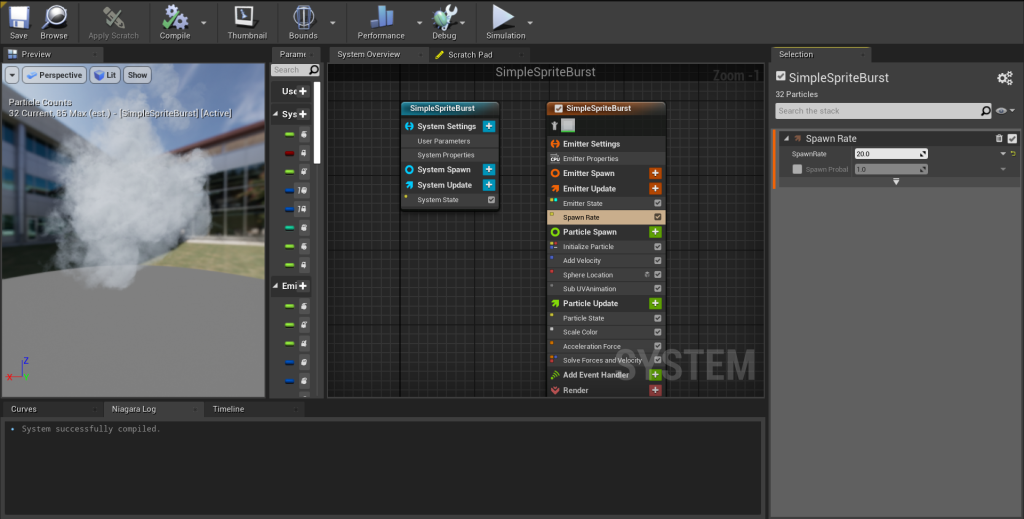Basic Effects
I jumped into Unreal Engine and created a small environment with some basic effects to give me an idea how they would react in a sequence. I investigated with some electric spark effects, placing them underneath a lamp. This effect can used in the sequence with the neon signs, but I have to differentiate the custom-made effect from the one in the starter content.

I also used smoke effects for the generators. All of the assets used in this exercise are from the city environment pack. (Epic Games, Inc, 2022). The smoke effect would be used for the canister’s lying around the scene as they billow into the air from the fire, and would be custom-made to differentiate it from the one used in the starter content.

Particle Effects
Smoke
For the sequence to be more immersive and engaging, we would be exploring particle effects and learn how to create some using Unreal’s Niagara System.

I developed the spawn rate to get a much smoky effect, setting it to 20.0 for more smoke and let the effect be obscuring objects when placed in front of something.

The video below outlines the overall result of the smoke experimentation after tweaking the properties inside of the emitter.
Fire
The materials on Canvas guided me on how to create a fire effect. Game Study Guide (2021) explains how to make custom effects from images and make them translucent, so this could work well for the fire effect. This is the result.

Placing them in the scene would make them behave as intended. I will try and make the particles less blocky when I eventually do this again. This effect will be used on top of the smoke effect inside a canister in the sequence.
Portal
I’ve also created a portal effect from the Canvas materials to demonstrate how comfortable I’m getting with these particle effects. This would be placed behind the character in the sequence.
Further Particle Experimentation
I wanted to experiment further with the Niagara systems, starting with the rain, used from Aspland (2022). I selected the fountain emitter, named it, and experimented with the parameters to make sure the effect is more like rain.

In my sequence, the effect will be in every scene, so I should be able to place the emitter above the area where I want it to activate.
I’ve created a blueprint to trigger the particles when a certain key is pressed. I plan to incorporate this into my sequence too as it can be useful to toggle the particles when they’re not on screen.
I’ve also created a material so that ripples would form when the raindrops reach the ground, taken from the method used by Cloward (2020). This is planned to be heavily used for Scene 2 by focusing on a puddle, but also used in every other scene too.
By masking this material, I can also apply them over existing materials to get a realistic output.
Sparks
Next up was the sparks that would emerge from the neon signs within my sequence. I created a new directional burst emitter and modified the template to make it more like electrical sparks, adapted from Dev Enabled (2020).

The effect doesn’t loop, which is what I want since the sparks aren’t continuous to place in the scene. The video below showcases the result.
References:
Aspland, M. (2022) How To Make Rain | Niagara Rain Particle System – Unreal Engine Tutorial [Video] Available online: https://www.youtube.com/watch?v=s_UQYuM1RWU [Accessed 13th November 2022]
Cloward, B. (2020) Rain Ripples Shader – UE4 Materials 101 – Episode 16 [Video] Available online: https://www.youtube.com/watch?v=ABWzKYc6UQ0 [Accessed 28th November 2022]
Dev Enabled (2020) UE4 Niagara Tutorial – Spark Effect – Intro to Niagara UE4/Unreal Engine 4 [Video] Available online: https://www.youtube.com/watch?v=I9hrGTIFXZs [Accessed 17th November 2022]
Game Study Guide (2021) Make Custom Particle Effects | Ue4 tutorial [Video] Available online: https://www.youtube.com/watch?v=wA-pqIybTHc&t=297s [Accessed 14th November 2022]